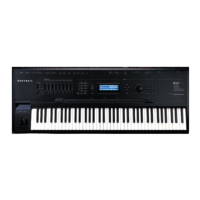Setup Mode
The Setup Editor
7-55
from A#0 to A#0 for example, and your riff will be triggered to start only by pressing the A#0
key. If you want your trigger key range to be larger, set your Trigger key range to be, for
instance, A#0 to A#1. Now any key that is pressed within this range will trigger your riff to
start.
Note: the LoKey and HiKey values on the KEYVEL page do affect the riff. If your riff's trigger and release
notes are not within the LoKey and HiKey range on the KEYVEL page, your riff will not be able to be
triggered from the keyboard.
Release
The way you release riffs is analogous to the way you trigger them. You can assign a physical
controller to destination 164 RiffOff, or you can select a key or key range with the Release
parameter. You set this the same way that you set the trigger range. Move your cursor so that the
left field of the Release parameter is highlighted (this will be the low end of the trigger key
range.) Now select a key value by using the Alpha Wheel, -/+ buttons or intuitive entry. Move
your cursor to the right field and repeat the process (this will be the high end of the trigger key
range.) If you set both of the Release values to A0, the Riff will stop when you release A0.
So, if you use the settings described above and in the Trigger section above, your setup’s riff will
start when you press A#0, and it will stop when you press and release A0.
Note: the LoKey and HiKey values on the KEYVEL page do affect the riff. If your riff's trigger and release
notes are not within the LoKey and HiKey range on the KEYVEL page, your riff will not be able to be
triggered from the keyboard.
Conditional Release (CondRel)
The CondRel parameter allows you to have a riff play only while a key is pressed and held, and
nothing will stop or restart that riff until the key is released. To use conditional release, set the
same range for the Trigger and Release ranges on the RIFF2 page. Any key that is pressed and
held within this range will play the selected riff. Release the key and the riff will stop. Playing
any other key in this zone while triggering a riff with CondRel–even if they are within the
Trigger and Release ranges–will not retrigger or stop the zone’s riff.
Local
If you want to trigger your riff without playing the current zone’s program, set Local to Off.
Local is set to Off by default since most users wont want to play the program in the zone they
are using for a riff, but only wish hear that zone’s program as a backing track. With Local set to
On, you will play the current zones program any time a key is pressed. This could create
undesired “grace notes” if you trigger a riff that has a downbeat at the same time you are
playing a note.
Loop
If you want your riff to loop indefinitely, set this parameter to Forever. If you want to have it
play once and then stop until you retrigger it, set this parameter to Once.
BPM
There are four choices here that will determine what controls the tempo of your riff. With BPM
set to Sequence, the original tempo in which the riff was recorded will be used. With BPM set to
Setup, the tempo set on the COMMON or Tap Tempo pages will be used. When syncing
multiple riffs it is convenient to set each riffs’ BPM parameter to Setup. Doing this, you can
change the tempo of all riffs at once with the Tap Tempo button or on the Tap Tempo page (see
Tap Tempo Button on page 7-4.) A value of Setup is also useful for syncing riffs to a zone’s

